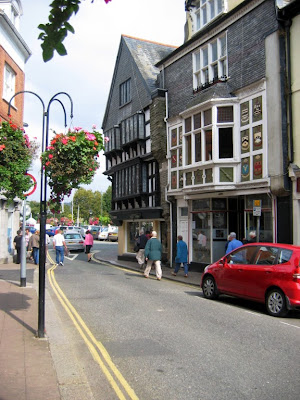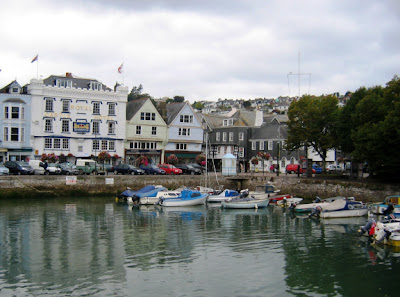This has been – and continues to be –
one of the busiest weeks in our part of South Devon: the height of
the summer plus school holidays plus the Royal Regatta at
Dartmouth. These combine to make travel a bit of a nightmare: lots of traffic with few available places to park. It can be even worse in the lanes.
Not their fault, of course, but the
visitors so often have little experience of driving in our country
lanes which are often barely wider than a car – as you can see.
Then when you meet someone coming in
the other direction there is a problem. One or other has to reverse
into an area which is just wide enough for you to pass each other
unless – and it happens quite often – there is such a place
between you. Generally this will be a slight widening of the road
giving just enough space to pass. The key is in those words “just
enough”. Those of us who have driven here most of our lives are
quite happy to stop only half an inch from a stone wall leaving a
space to our right which is perhaps three inches wider than the
incoming car. Likewise, if we are driving that oncoming car, we are
more than happy with that. We pull in our wing mirrors and off we go.
Those not used to the lanes are less content. Some pass by slowly and
carefully but others just freeze and look helpless.
 |
| It's not just other vehicles: livestock seem to think they own the place. They are probably right. |
It is grossly unfair but then we say
things like, “Come on for heaven’s sake. You could drive a bus
through there!” in exasperated terms. This driver could not drive
his or her car through there – let alone a bus. BUT if, like me,
you rarely drive in large towns or cities, where the speed of the
traffic switching from lane to lane with breath-taking confidence
induces a sense of absolute terror, it behoves you to treat these
drivers with courtesy: in their own comfort zones they are as
confident and happy as are we in ours. Just as we fall to pieces when
outside ours, so do they.
Thus, cursing under our breaths, we
reverse as far as it takes to find a wider passing place, perhaps a
gateway into a field or a road junction. We shall probably do this
with complete insouciance never looking over our shoulders but with
eyes flicking between our wing mirrors with the odd glance at the
interior mirror. We are not showing off: reversing for long distances
while turning your head round is somewhere between uncomfortable and
downright painful so we soon learn to do it on mirrors alone.
 |
| They may be narrow but there are some lane verges that are delightful. They are at their best in spring but still god here, three weeks ago. |
However, we are probably breaking the
law. The law does not encourage people to drive backwards down the
roads and covers this with a simple regulation known as clause 203 of
Law CUR reg 106: “You MUST NOT reverse your vehicle further than
necessary.”
Putting aside the fancy name (I’m not
quite sure what “Law CUR reg 106” means but it does sound like
something rather distasteful) it poses a question. The capital
letters are enshrined in that law, by the way, and they are sometimes
printed in BOLD. The problem
is contained in the word “necessary”.
If
there really is enough space but one driver has insufficient
confidence to drive through it, does that make it “necessary” in
the eyes of the law for the other driver to reverse one inch let
alone (as sometimes happens) a few hundred yards? Most of us don’t
give this a thought, we do what we deem to be “necessary” and
most of us do it cheerfully and then wave happily at the other driver
as he or she passes by. Come to think of it, that driver is probably
an accessory to this crime.
There are times –
are there not? – when the law is an ass.
Still, come the
end of next week after the schools start their autumn terms we shall
all be back to normal. We shall still meet others in the lanes but
when two “locals” meet they somehow size up the situation and
quickly come to what feels like a mutual decision as to the best way
to solve the impasse. Anyway, if you are not that happy in these
narrow lanes there is no need to use them: they rarely lead anywhere
that isn’t served by quite decent roads.
Last evening, Marcia and I went for a walk beside the River Avon at Shipley.
 |
| We were lucky to see the dipper - a long was away as usual but always a delight. |
 |
| It was Marcia who spotted this lichen draped over a thorn bush. |
 |
| No question but that autumn is nearly on us when the rowan berries appear. |
Chadwick aficionados will remember that it was here that Miles suffered a stroke so perhaps I should add that there was no such disaster yesterday.
 |
| Meet Filo. |

























